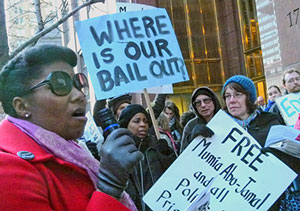Occupy movement challenges prison-industrial complex
By
Betsey Piette
Philadelphia
Published Mar 4, 2012 9:49 PM
Demonstrators chanted, “Tear down Jailhouses! Build up School Houses!” outside Heery International Inc.’s Philadelphia office as part of a national call from Occupy Oakland to Occupy for Prisoners on Feb. 20.
|
Jamila Wilson addresses Feb. 20 rally.
WW photo: Joseph Piette
|
Organized by DecarceratePA and endorsed by Occupy Philadelphia, the protest targeted the disparity between increased funding for prison construction while Pennsylvania Gov. Tom Corbett slashes funding for education and is pushing for more cuts.
Heery, which profits from private prison construction, was paid $316 million in October to build a Graterford Prison extension to house 4,100 more inmates and a new death row facility.
Political prisoner Mumia Abu-Jamal’s statement was a rally highlight. Now housed in general population at Pennsylvania’s SCI-Mahanoy prison, a decades-long struggle won his December release from death row. He said of the call to Occupy for Prisoners, “It was not an especially radical call, but it was right on. Prisons have become a metaphor — the shadow-side … of America. With oceans of words about freedom — and the reality that the U.S. is the world’s leader of the incarceration industry — it’s more than time for the focused attention of the Occupy Movement.
“Every state, every rural district, every hamlet in America has a prison, a place where the Constitution doesn’t exist and where slavery is all but legalized. And where there are prisons, there is torture: brutal beatings, grave humiliations, perverse censorship — and even murders.”
Abu-Jamal called on the Occupy Movement to support the calls for freedom for political prisoners Leonard Peltier, the MOVE 9, Sundiata Acoli, Russell “Maroon” Shoatz and others, but urged the movement to do more to stop “a destructive, counter-productive, annual $69 billion boondoggle of repression, better known … as the Prison Industrial Complex.” He urged the Occupy Movement to build “a mass movement that demands and fights for real change,” and concluded, “Down with the Prison Industrial Complex!”
Theresa Shoatz read her father’s statement; Russell “Maroon” Shoatz has been held for 21 years in solitary confinement at SCI Green. Former inmates also spoke.
More than 700 people demonstrated outside San Quentin on Feb. 20, stressing, “Unless all of us are free, we are all imprisoned.” Many protesters had been illegally arrested and imprisoned at Occupy Oakland.
Kevin Cooper, a San Quentin death row prisoner, inspired the call to Occupy for Prisoners initiated by Occupy Oakland. He urged the Occupy Movement to include prisoners in their movement for the 99%, saying, “No man or woman on death row … is a ‘have.’ We are the ‘have nots.’ We are the bottom 1%.”
Protests took place in 19 cities, including New York, Los Angeles, Chicago, Washington and Durham, N.C., where their flier noted, “Prior to incarceration, two-thirds of all prisoners lived in conditions of economic hardship, while the perpetrators of ‘white-collar’ crime largely go free.” No Wall Street banker has been jailed for stealing billions of dollars through mortgage fraud.
Occupy for Prisoners exposed mass incarceration in the U.S. — the world’s largest jailer — where more than 3 million people are behind bars.
More African Americans in prison today than enslaved in 1850
Michelle Alexander, author of “The New Jim Crow: Mass Incarceration in the Age of Colorblindness,” says there are “more African-Americans … in prisons or jail, on probation or parole — than were enslaved in 1850, a decade before the Civil War began.” Between 1970 and 1995, the incarceration of African Americans increased seven-fold.
African Americans make up 12 percent of the U.S. population but comprise 40 percent of the prison population — a legacy of more than three decades of the so-called “war on drugs” with its “three strikes” bills, mandatory harsh prison terms and jail time for minor drug offenses.
Occupy events targeted for-profit prisons and companies like Wells Fargo, which is heavily invested in the private prison industry with 3.5 million shares in the second largest prison operator, the GEO Group. Companies make money through prison construction and from prison labor, paying prisoners as little as $0.23 an hour.
The disparity in funding for prisons versus education and the incarceration of juveniles as adults were common themes. The Broad Foundation says the U.S. spends $9,644 to educate a student but $22,600 per prison inmate. High school dropouts comprise 65 percent of U.S. prisoners.
Protesters condemned the widespread use of solitary confinement and outright torture inside U.S. prisons. Prison Legal News explains, “The kind of torture of prisoners at Abu Ghraib in Iraq … is commonplace within U.S. prisons.”
Super max prisons hold an estimated 20,000 U.S. prisoners in solitary, while thousands more are so confined in state and local prisons, including hundreds of Muslims.
Prolonged solitary confinement is recognized internationally as torture, which violates the Universal Declaration of Human Rights, the U.N. Convention against Torture and the U.N. Convention on the Elimination of all forms of Discrimination.
Abu-Jamal, who spent nearly 30 years in solidarity, told Occupy for Prisoners, “Justice demands the end of solitary … it is no more than a modern-day torture chamber for the poor.”
Articles copyright 1995-2012 Workers World.
Verbatim copying and distribution of this entire article is permitted in any medium without royalty provided this notice is preserved.
Workers World, 55 W. 17 St., NY, NY 10011
Email:
[email protected]
Subscribe
[email protected]
Support independent news
DONATE


